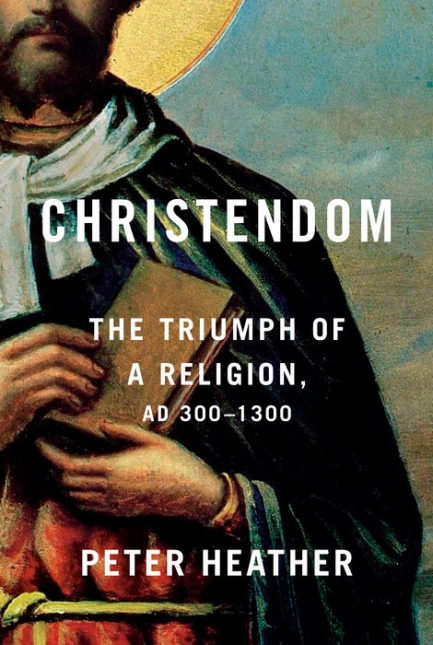Christendom: The Triumph of a Religion, AD 300-1300
- By Peter Heather
- Knopf
- 736 pp.
- Reviewed by Bob Duffy
- April 25, 2023
A bold reinterpretation of the faith’s nascent days.

Peter Heather’s history of Christianity through AD 1300 dispenses with the usual two-century run-up of wandering apostles, catacombs, and lions in the colosseum. Rather, in Christendom, the author takes up his story during the religion’s organizational adolescence in Rome and Constantinople, those twin centers of imperial rule. In his account, it was a time when Christianity was enjoying increasing favor in government circles and its earlier hagiographic pyrotechnics had faded. What was left were thorny doctrinal debates and the occasional self-asserting rebellion of a patriarch or a distant faith community.
The 10-century throughline of this magisterial volume hews closely to the spiky interaction of central authority — first imperial, later papal — and the exercise of personal piety among laity and clergy. As Heather’s recounting begins, the emperor Constantine, aglow with the Christian god’s demonstrated favor, is signing up as a convert. Pagan temples and communities are resisting official calls for their destruction, and Christianity is on the brink of enshrinement as the religion from the North Sea to the Bosporus, its domain neatly circling the Mediterranean.
Adequately covering a thousand years of ecclesiastical governance and personal piety demands prodigious scholarship, of course, and Heather, the chair of medieval history at King’s College, London, answers the call admirably. He’s produced a learned, exhaustive, and spritely account of the religious goings-on wherever Masses were celebrated. Academics and librarians will likely applaud this book. But casual readers? That may be another matter.
Unless you’re a diehard fan of the era(s) or of religious history, it may take some grit to trek through Heather’s 600 pages of text, his 30 pages of endnotes in close-set, stunningly miniscule type, and another 50 pages listing some 2,000 book-length bibliographic sources (albeit with some puzzling omissions, including Bart D. Ehrman, Elaine Pagels, and Diarmaid MacCulloch). Even so, the index is good, so you’re reasonably well provisioned for a here-and-there pilgrimage (or crusade) through the saga he recounts.
Speaking of crusades and pilgrimages, Heather’s coverage of the last three centuries of his allotted span is particularly incisive, notably when he characterizes the Crusades as “the foreign policy of the Papacy.” He also notes that “crusading was just a nasty quid pro quo, which allowed warrior groups to validate their bloody and self-gratifying wars of acquisition.” His commentary on the other preoccupations of the laity at the time — the pilgrimage craze itself, indulgence-trafficking and relic scams, and the emerging cult of the Virgin Mary — while not intensive, sheds much-needed light on these hallmarks of the period.
There are likely to be big surprises, too, at least for lay readers, and many points of disagreement for traditional scholars. For one, Heather credits Christianity’s early spread not so much to the dawning piety of the Roman populace as to private initiatives among the oligarchy. The faith’s footprint in 4th-century Rome, he asserts, was a network of chapels commissioned by “members of the Roman elite for their own use” and employing their own expressly hired priests, presumably with no loyalties to formal ecclesiastical authority.
Many of these upper-class patrons were female, a circumstance that led the contemporary theologian (and eventual saint) Jerome to characterize them disparagingly as “a senate of matrons.” Similarly, in Constantinople, the bishops only gained full control of parish churches in the 6th century:
“Even the patriarch remained a relatively marginal figure, not at the center of the most important Christian developments in the city, and could even find himself in trouble if he annoyed the wrong patrons.”
If anything, writes Heather, it was the government early on, and not the bishops nor the pope in Rome, who called the shots; Christianity “was in effect a department of the imperial state, and joining its ranks was another way to serve the emperor.” This position might crinkle the starched collars of rival historians, especially those of a clerical stripe.
The publicity for this work stresses Heather’s role as brilliant disrupter of traditionally held scholarship. For those among us nurtured in the parochial regimes of the last century, this is not entirely unwelcome.
Bob Duffy, a retired ad agency VP and once-upon-a-time academic, reviews frequently for the Independent.

